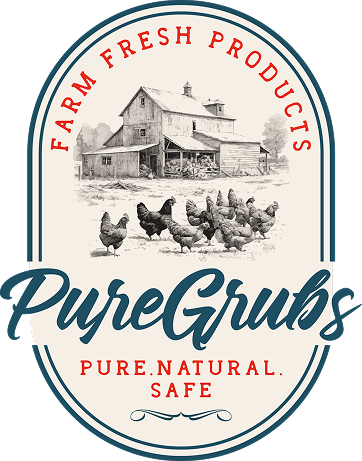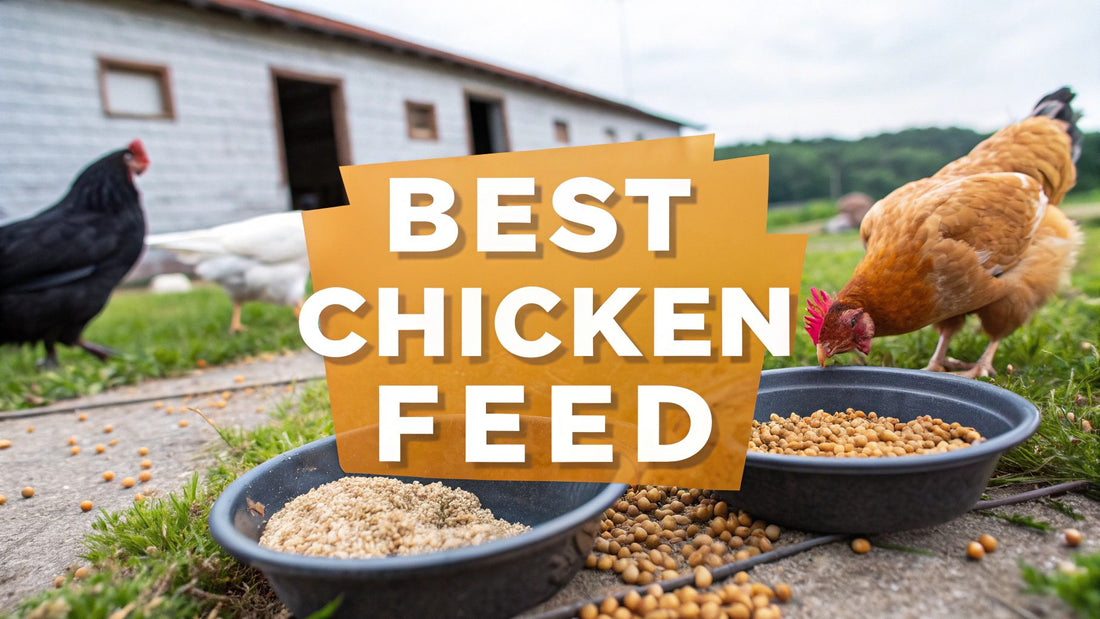
What Is the Best Food for Chickens? An Ultimate Guide
Share
The absolute best food for your chickens is a complete, age-appropriate commercial feed. It’s specifically formulated to deliver the perfect balance of protein, vitamins, and minerals they need to thrive. While fun supplements and tasty treats have their place, a high-quality feed must always be the cornerstone of their diet.
The Foundation of a Healthy Flock
When people ask me what the best food for chickens is, I like to use a simple analogy: think of their diet like building a house. You can't just throw a pile of lumber on a lot and expect a sturdy home to appear. You need specific materials—nails, insulation, wiring, plumbing—all in the right amounts.
A chicken's body works the same way. Tossing out some scratch grains or kitchen scraps is like trying to build that house with only wood. You're missing critical components. A complete commercial feed, on the other hand, is the carefully designed blueprint that ensures your flock's health, providing a balanced mix of six essential nutrient groups that work in harmony.
The Six Pillars of Chicken Nutrition
Getting a handle on these core nutrients is the first step to really understanding what you're feeding your birds. Each one plays a vital, non-negotiable role in a chicken's daily life.
- Protein: This is what builds your chicken. It’s absolutely essential for muscle development, feather production, and repairing tissue. Skimp on quality protein, and you’ll see poor growth and weak birds.
- Carbohydrates: This is their fuel. Carbs from grains like corn and wheat power everything they do, from scratching around the yard to just keeping their bodies warm on a cool night.
- Fats: Fats are a super-concentrated energy source, but they're also crucial for absorbing key vitamins. They also provide essential fatty acids that support cell health and can even lead to richer, more vibrant egg yolks.
- Vitamins: These are the unsung heroes of a chicken's diet. Vitamins like A, D, E, K, and the B-complex group are vital for a strong immune system, bone development, good vision, and countless metabolic processes.
- Minerals: For laying hens, minerals like calcium and phosphorus are the headline act. Calcium is the main ingredient for strong eggshells. A deficiency here quickly results in thin, brittle, or even shell-less eggs.
- Water: It’s easy to forget, but fresh, clean water is the single most important nutrient of all. It’s involved in every single bodily function, from digestion to regulating body temperature. A dehydrated chicken is a sick chicken.
Why Balance is Everything
Just having these nutrients available isn't enough; the balance between them is what truly matters. For example, calcium and phosphorus have a very specific relationship. A hen needs the correct ratio of both for her body to properly use the calcium to form an eggshell. If the ratio is off, too much of one can actually block the absorption of the other.
Think of it this way: Having a big pile of bricks (calcium) is useless if you don't have the right amount of mortar (phosphorus and Vitamin D) to hold it all together. A good complete feed gets this delicate balance exactly right.
This is precisely why a well-formulated commercial feed is the best choice for the bulk of their diet. It takes all the guesswork out of their nutrition, ensuring your flock gets everything it needs to thrive, lay beautiful eggs, and live a healthy, active life. Get this foundation right, and everything else falls into place.
How to Choose the Right Commercial Chicken Feed
Walking into a feed store can be overwhelming. You're hit with a wall of bags—starter, grower, layer—in mash, crumbles, or pellets. It’s a lot to take in, but picking the right commercial feed is hands-down one of the most critical decisions you'll make for your flock's health.
Think of it like feeding a person through different stages of life. You wouldn't give a newborn a steak; they need a special formula to grow. Chickens are no different. Their nutritional needs shift dramatically as they go from fragile little chicks to strong, egg-laying adults.
Matching Feed to Flock Age
The first and most important rule is to match the feed formula to your flock's age. Each type is carefully balanced to deliver the precise protein, calcium, and energy a chicken needs at that specific point in its life. Getting this wrong can stunt their growth, lead to weak bones, and cause all sorts of egg-laying problems down the road.
Here’s the simple breakdown of the three main types:
- Starter Feed (0-8 Weeks): This is the high-octane fuel for a chick's explosive growth phase. Packed with 20-24% protein, it has a fine, crumbly texture that's easy for tiny beaks to manage. That high protein isn't optional—it's the essential building block for their organs, muscles, and first set of feathers.
- Grower Feed (9-18 Weeks): As your birds enter their "teenage" phase, their protein requirements dip a bit. Grower feed bridges this gap with a more moderate 16-18% protein and lower calcium. It’s designed to support steady, healthy growth without rushing them into laying eggs before their bodies are fully developed.
- Layer Feed (18+ Weeks): Once your hens start laying, or right around the 18-week mark, it’s time to switch to layer feed. The protein stays around 16-18%, but the real game-changer is the huge boost in calcium, often jumping to 3.5-5%. This mineral is absolutely vital for forming strong, perfect eggshells day after day.
This infographic gives you a fantastic visual of what a balanced diet looks like for a healthy, laying hen.
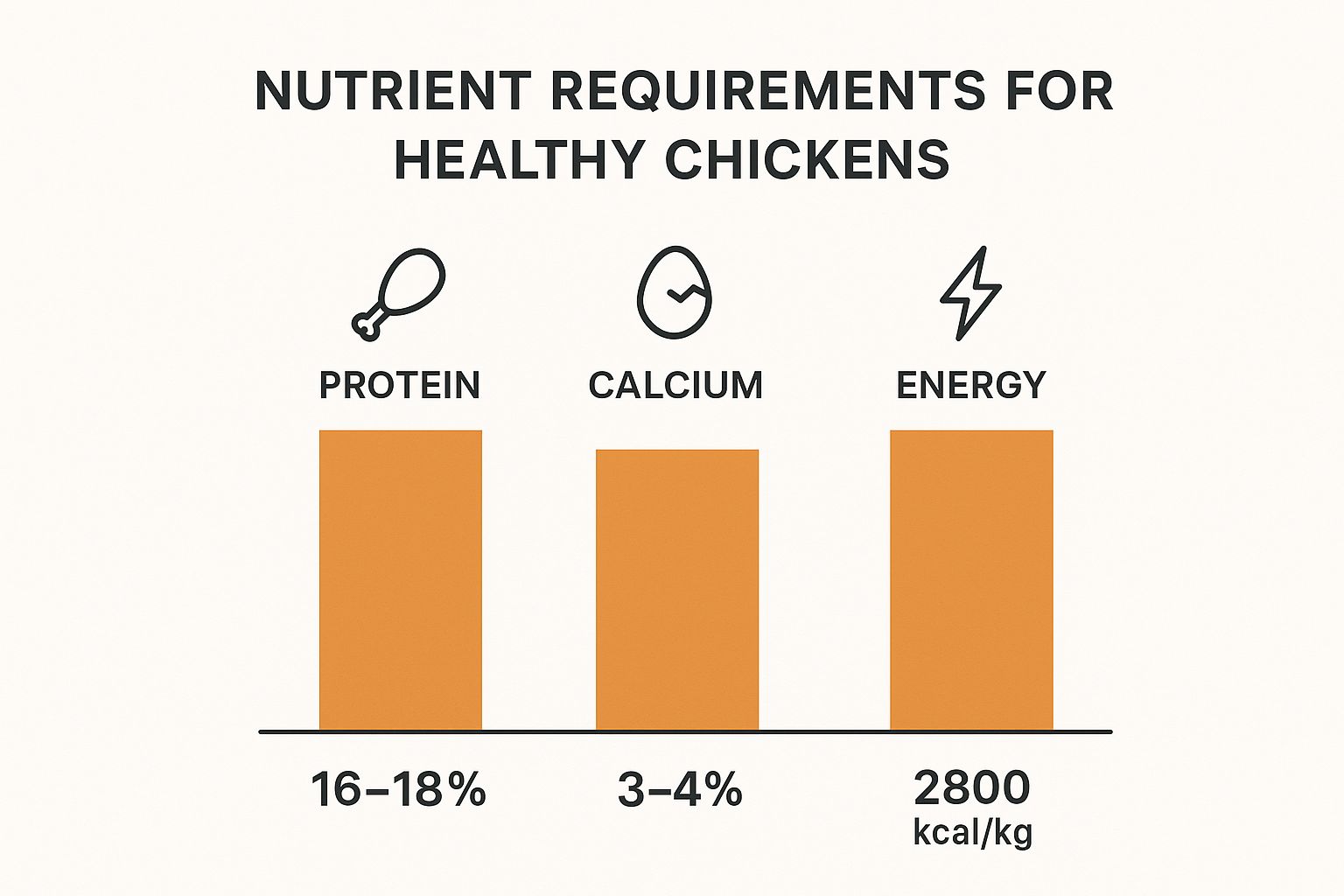
As you can see, it's a precise balancing act. Protein, calcium, and energy all have to be in the right proportions to keep your flock healthy and the eggs coming.
A word of caution: Switching to layer feed too early can cause serious kidney damage in young birds because of the high calcium. On the flip side, keeping laying hens on grower feed will lead to thin, rubbery eggshells and can force them to pull calcium directly from their own bones.
If you're really aiming for top-tier eggshell quality, it’s worth diving deeper into the specifics of high-calcium chicken feed.
Commercial Chicken Feed Types at a Glance
To make it even clearer, here’s a simple table comparing the main feed types you’ll find at the store.
| Feed Type | Primary Purpose | Typical Protein % | Key Nutrients | Best For (Age) |
|---|---|---|---|---|
| Starter | Rapid growth and development | 20-24% | High Protein | 0-8 Weeks |
| Grower | Steady maturation | 16-18% | Moderate Protein, Low Calcium | 9-18 Weeks |
| Layer | Eggshell production and health | 16-18% | High Calcium (3.5-5%) | 18+ Weeks |
This table helps you see at a glance why feeding the right formula at the right time is so crucial for raising a healthy flock.
Crumbles, Pellets, or Mash
Once you've picked the right formula, you have to decide on its physical form. This choice often comes down to your flock's age and your own preferences for managing waste.
Mash is the most natural form—it's just finely ground-up ingredients. It’s perfect for baby chicks who can’t swallow anything bigger. The downside? It can be messy, and clever chickens will often pick out their favorite bits, leading to an unbalanced diet and a lot of wasted feed on the coop floor.
Crumbles are basically just pellets that have been broken up into smaller, bite-sized pieces. This is a great all-around choice. It’s small enough for growing birds but big enough to cut down on the picky eating and waste you get with mash.
Pellets are the cleanest and most efficient option. The ingredients are compressed into a uniform nugget, which means every single bite is nutritionally complete. Chickens can't pick and choose, so you know they're getting a balanced meal every time. It’s my go-to for adult flocks.
Ultimately, choosing the best food for your chickens is about confidently matching a complete commercial feed to their life stage. When you understand the difference between starter, grower, and layer—and the pros and cons of mash, crumbles, and pellets—you're setting your flock up for a long, healthy, and very productive life.
The Science Behind Modern Chicken Feed
Ever wonder what's actually in that bag of chicken feed you grab at the local co-op? It's easy to assume it's just a simple blend of grains, but the truth is far more complex. That feed is the result of a massive, science-backed global industry working tirelessly to perfect poultry nutrition.
Thinking about this bigger picture helps you understand what makes a chicken feed good and why the quality formulas work so consistently well for flocks everywhere.
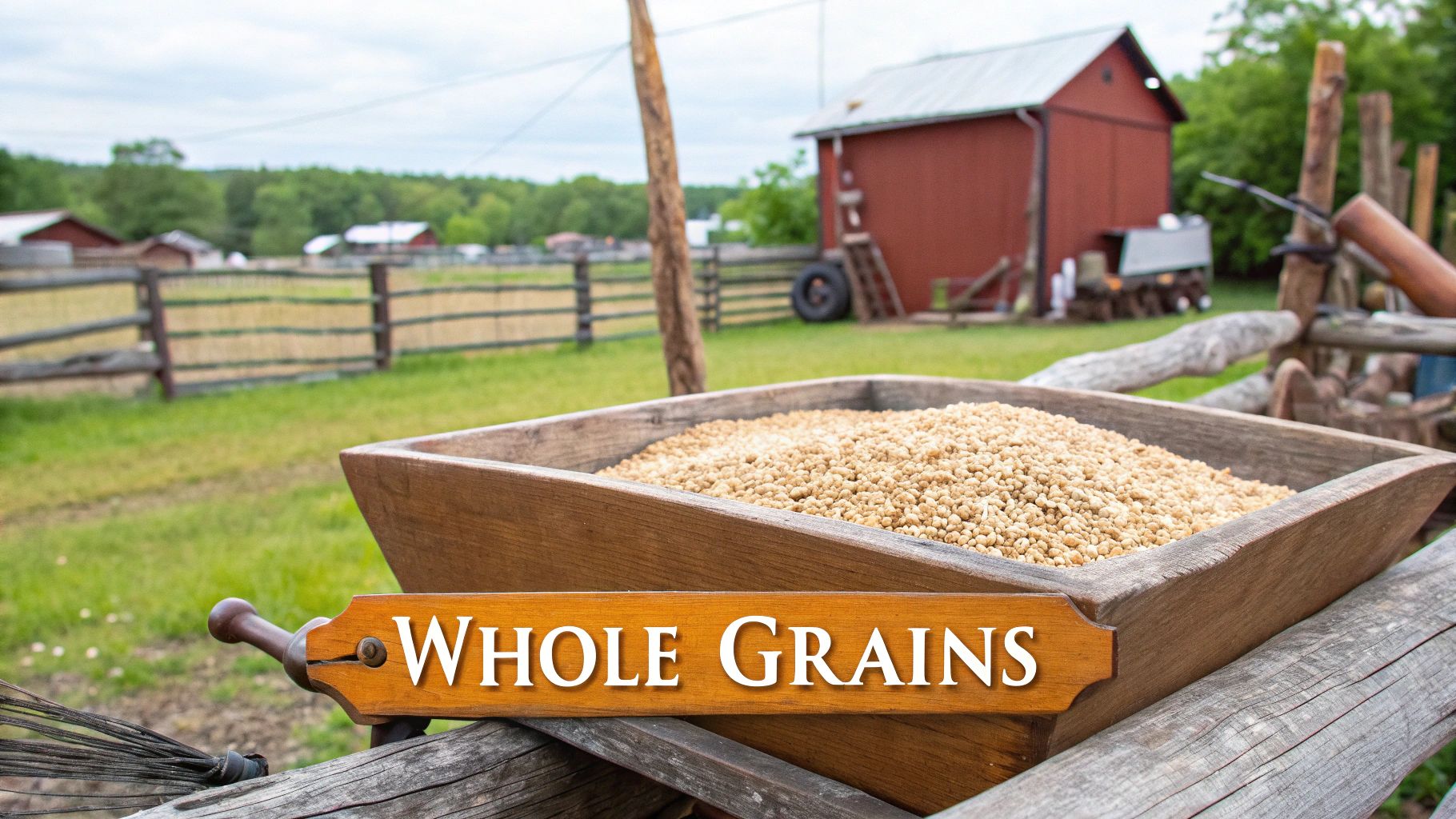
The driving force behind all this? The world’s incredible demand for chicken and eggs. As our appetite for poultry has skyrocketed, so has the investment in research to create feeds that boost health, growth, and productivity. This isn’t just about making bigger chickens, but about dialing in their diet to deliver the exact nutrients they need to thrive.
A Global Industry in Your Feed Scoop
The scale of this operation is staggering. The global poultry feed market was valued at USD 175.9 billion back in 2018, and it's been climbing ever since. This growth has fueled incredible breakthroughs in animal nutrition, leading to the highly effective, balanced formulas we see on shelves today. If you want to dive deeper, this Grand View Research industry analysis paints a clear picture of the market's size.
So, what does that mean for your backyard birds? It means that every scoop of feed is packed with decades of scientific refinement, all aimed at finding the perfect balance of:
- Amino Acids: These are the fundamental building blocks of protein, essential for everything from feathering and muscle to overall development.
- Vitamins and Minerals: They're precisely measured to support a robust immune system and, in laying hens, to produce strong, healthy eggshells.
- Energy Sources: The energy content is carefully calibrated to keep your chickens active and healthy without causing them to become overweight.
This scientific rigor takes all the guesswork out of feeding your flock. A quality commercial feed is essentially a complete, expertly crafted meal in a bag.
The feed in your coop isn’t just a local product; it’s the result of international research and market trends. Regions like the Asia-Pacific, which dominate market share, drive innovation that benefits flock owners everywhere by creating more efficient and nutritionally sound formulas.
From the Lab to Your Backyard
This global perspective really matters because it shows that finding the "best food for chickens" is no accident. It’s a sophisticated process led by nutritionists, veterinarians, and agricultural scientists who dedicate their careers to this work. They study how different ingredients work together, how nutrients are absorbed, and which specific ratios lead to the healthiest birds and the best-quality eggs.
Take broiler operations, for example. Since they make up over 65% of the market, there's been a huge push to develop feeds that promote fast, healthy growth. That research taught us volumes about how specific amino acids can improve feed conversion, meaning chickens get more nutritional bang for every buck—or peck.
These advancements don't just stay in the commercial world; they trickle right down to the feed you buy for your small flock. The same core principles that keep huge commercial flocks healthy are used to formulate the feed for your handful of hens. When you choose a reputable brand, you're tapping into a massive body of scientific work aimed at one simple goal: giving chickens the best diet possible.
Giving Your Flock a Nutritional Edge with Natural Supplements
A high-quality commercial feed is the cornerstone of a healthy chicken diet, no doubt about it. But if you want to see your flock truly thrive, think of natural supplements as the secret weapon that elevates their health from good to great. We're not talking about empty-calorie "treats" like a chunk of bread. We're talking about functional foods that fill in tiny nutritional gaps, boost overall wellness, and let your chickens act like, well, chickens.
The main difference comes down to purpose. A treat is mostly for fun and building a bond—it doesn't offer much in the way of nutrition. A supplement, on the other hand, does a specific job, like helping with digestion or building stronger eggshells. The golden rule for both is simple: keep it to no more than 10% of your flock's total daily diet to avoid throwing their core nutrition off balance.
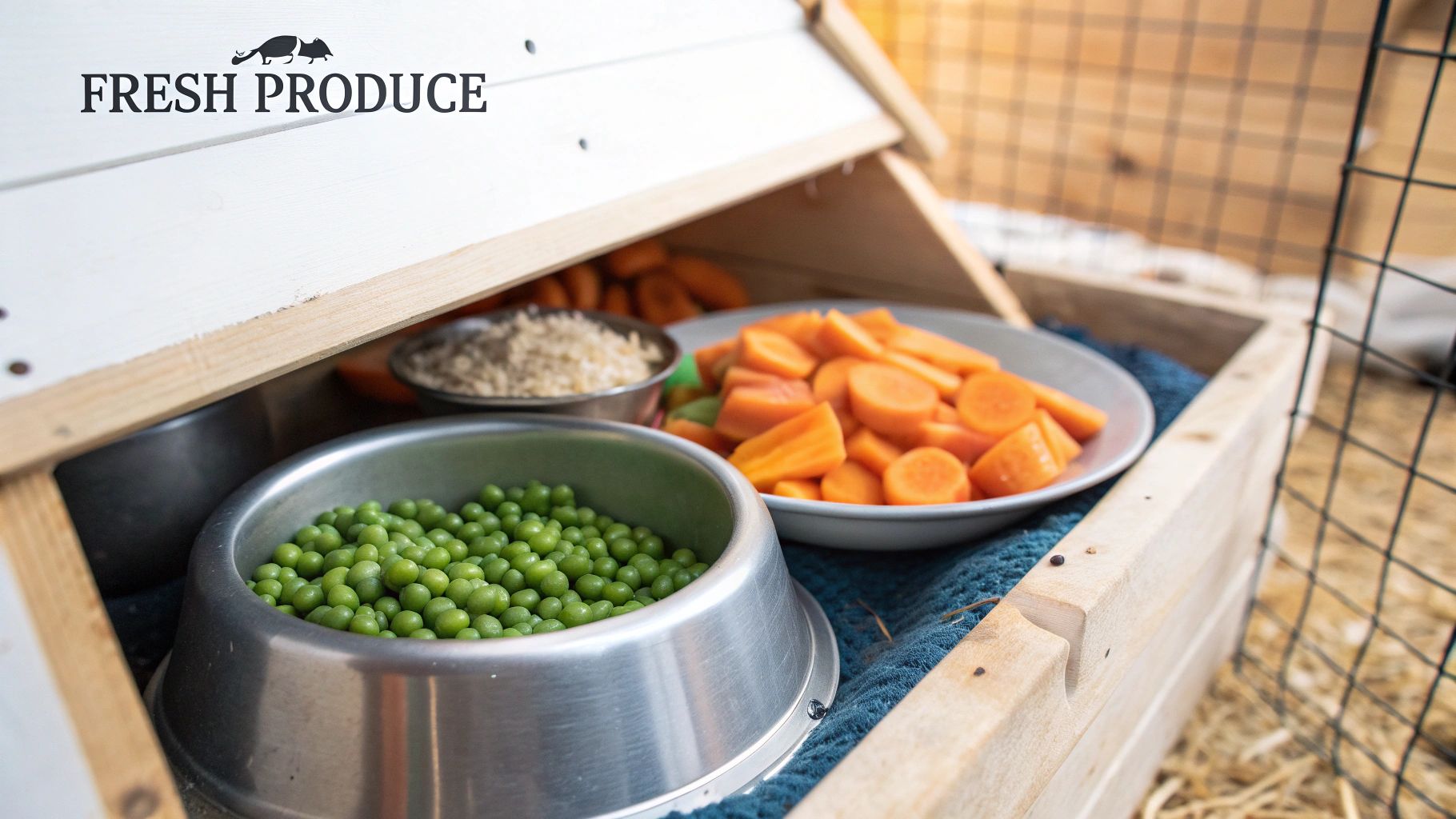
The Non-Negotiables: Two Add-Ins Every Flock Needs
Beyond their main feed, there are a couple of supplements that should always be available to your flock. I like to think of these as essential, not optional, because they're vital for digestion and egg production.
- Grit: Chickens don’t have teeth. To break down their food, they use a powerful muscular organ called the gizzard, which needs a supply of tiny stones and sand to do its grinding work. If your birds are free-ranging on varied ground, they might pick up enough on their own. But to be safe, it's always smart to offer a separate dish of commercial grit so they can take what they need.
- Oyster Shell: Even though layer feed is packed with calcium, some hard-working hens just need a little extra. By providing a separate dish of crushed oyster shell, you empower them to self-regulate their intake. This ensures they have everything they need for strong, perfect eggshells without having to pull that calcium from their own bones—a process that can lead to serious health problems down the road.
Using Kitchen Scraps the Smart Way
Your kitchen can be a treasure trove of healthy extras for your flock, but you have to be careful about what you share. The best scraps are whole, unprocessed foods that add a nice boost of vitamins and minerals.
Things like leafy greens (kale and spinach are big hits), leftover cooked rice, oatmeal, and most veggies and fruits are fantastic in moderation. They add valuable nutrients and a bit of excitement to the daily routine. However, a few common foods are outright toxic. Never, ever feed your chickens avocado, uncooked beans, green potato skins, or anything that's moldy, overly salty, or sugary.
Think of your chickens' diet like a well-balanced plate. Their commercial feed is the main course, covering all the essential protein, carbs, and fats. Healthy supplements like leafy greens are the side salad, adding extra vitamins and fiber. Grit and oyster shell are the salt and pepper—they don't add calories, but they make the whole system work.
The Power of Letting Chickens Be Chickens
One of the best and most natural ways to supplement your flock's diet is to simply let them forage. When you see a chicken scratching around in the grass, they're not just killing time. They are on a mission, actively hunting for the exact nutrients their bodies are telling them they need.
Foraging gives them a varied menu of:
- Protein-Packed Bugs: Chickens go crazy for insects, worms, and larvae. This is their natural source of protein, which is crucial for feather growth and muscle development. It's why using dried grubs for chickens as a supplement works so well—it taps directly into this instinct.
- Nutrient-Dense Greens: Weeds and fresh grass shoots are a fantastic source of vitamins and chlorophyll.
- Essential Seeds: They'll also find wild seeds, which provide healthy fats and an extra pop of energy.
This instinctual behavior isn't just about food; it's also about mental and physical exercise. A foraging chicken is a busy, happy, and healthy chicken. When you combine a top-notch feed with smart supplements and the chance to forage, you're creating a holistic diet that helps your flock absolutely flourish.
Why BSFL Are a Superior Protein Supplement
If you think of a complete commercial feed as the solid foundation of your flock's diet, then Black Soldier Fly Larvae (BSFL) are the high-performance superfood that takes their health to the next level. This isn't just another barnyard treat. It’s a powerful supplement that taps directly into what chickens would naturally forage for in the wild—a diet packed with insects.
By feeding this instinct, you’re giving them a nutritional boost you can actually see in their energy, the sheen of their feathers, and the quality of their eggs. BSFL are uniquely built to meet a chicken's needs, offering a concentrated source of the exact nutrients a thriving flock requires.
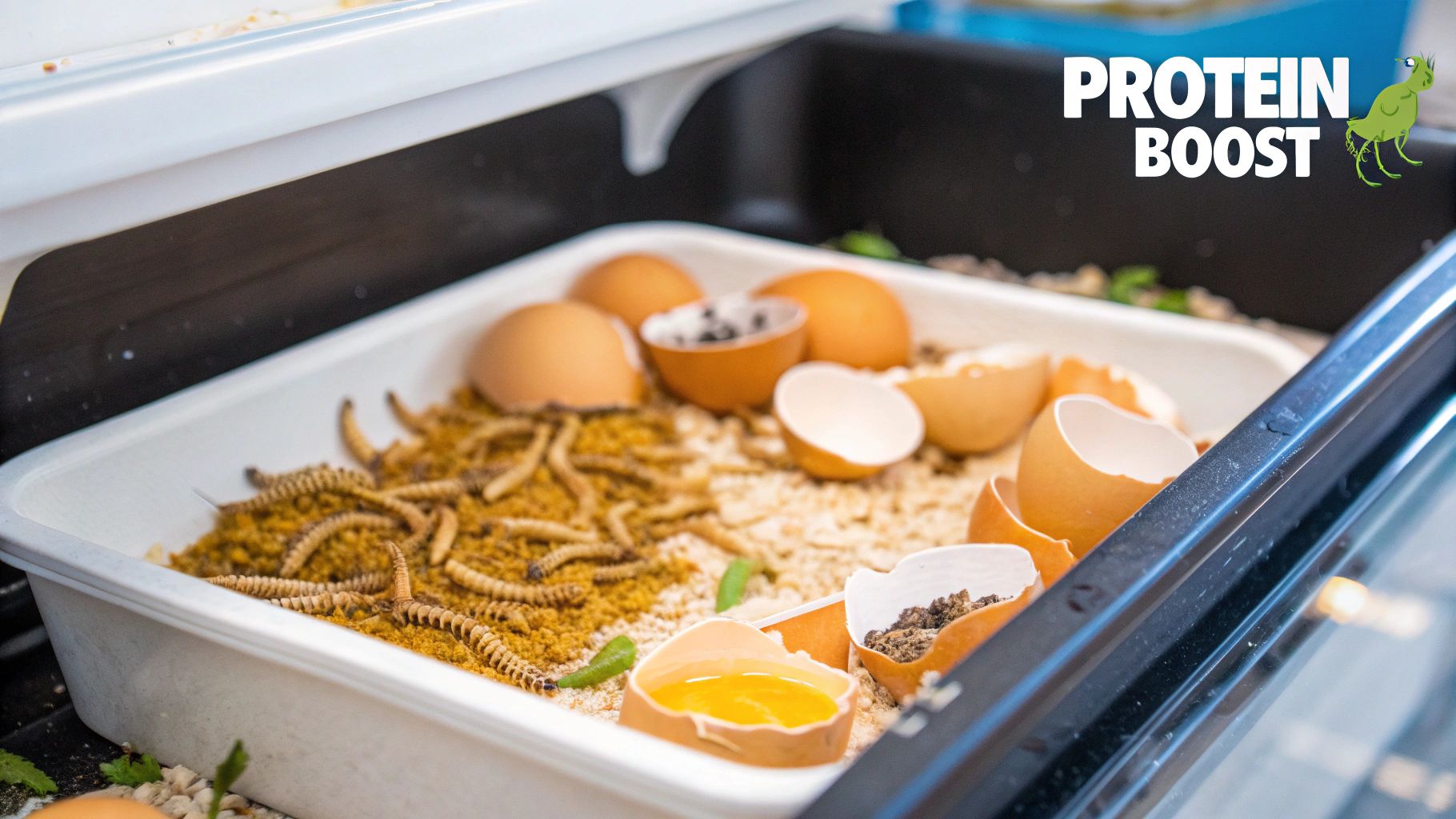
Unpacking The Nutritional Power of BSFL
So, what makes BSFL such a standout choice? It all comes down to a perfect storm of protein, essential amino acids, and a game-changing calcium-to-phosphorus ratio. These elements work together to directly support a chicken’s most vital functions.
First off, BSFL are loaded with highly digestible protein, often making up 40-50% of their dry weight. This isn't just empty protein, either. It's rich in essential amino acids like methionine and lysine, which are the literal building blocks for healthy feather growth and strong muscle development. Chickens going through a tough molt especially benefit from this protein punch, as it helps them regrow their plumage quickly and efficiently.
This move towards targeted, high-quality ingredients is becoming more common. The poultry feed market is expected to hit around USD 240.4 billion by 2025, largely because chicken keepers are demanding feeds that do more than just provide basic energy. Innovations now include specialty additives that help with nutrient absorption and overall health, confirming what many of us have known for a while: the best food for chickens combines a balanced profile with performance-boosting ingredients.
The Calcium Advantage For Stronger Eggshells
Maybe the biggest win for BSFL is hidden in their mineral content. Unlike most other insect treats, BSFL have an incredibly high level of calcium. But even more importantly, they have a naturally ideal calcium-to-phosphorus ratio, which is absolutely critical for how a hen’s body absorbs and actually uses that calcium.
A hen can't build strong eggshells with calcium alone; she needs the right amount of phosphorus to help her body process it. BSFL deliver both nutrients in perfect harmony, making them one of the most effective ways to prevent thin, brittle, or soft-shelled eggs.
With every handful, this balanced mineral profile directly supports your flock's reproductive health. The visible result is consistently stronger, smoother eggshells and healthier, more resilient hens. It's a key reason why so many flock owners are learning where to buy Black Soldier Fly Larvae to make this superfood a regular part of their feeding routine.
BSFL vs Mealworms: A Nutritional Showdown
When folks start looking for insect treats, mealworms are often the first thing that comes to mind. While chickens will gobble them up, mealworms are basically chicken candy—high in fat but pretty unbalanced nutritionally. A side-by-side comparison makes it clear why BSFL are the superior choice.
Here’s a quick look at how they stack up.
BSFL vs Mealworms A Nutritional Showdown
| Nutrient | Black Soldier Fly Larvae (BSFL) | Mealworms | Benefit for Chickens |
|---|---|---|---|
| Protein | High (~40-50%) | Moderate (~20%) | Supports feather growth and muscle health. |
| Calcium | Very High (~2-3%) | Very Low (~0.05%) | Essential for strong eggshells and bone density. |
| Fat | Moderate (~30%) | High (~40%) | Provides energy; BSFL offer a healthier balance. |
| Ca:P Ratio | Ideal (~2:1) | Poor (~1:7) | Ensures efficient calcium absorption. |
As the table shows, BSFL deliver exactly where it counts most. They provide far more of the good stuff—protein and calcium—and a much better mineral balance for your birds.
Choosing BSFL over mealworms isn't just a small tweak; it’s a strategic decision to give your flock a supplement that actively improves their health. The benefits often show up in just a matter of weeks. Flock owners who make the switch frequently report shinier plumage, richer golden egg yolks, and a noticeable uptick in their birds' energy and activity levels. By supplementing with BSFL, you’re providing a functional food that truly helps your chickens thrive from the inside out.
Foods That Can Seriously Harm Your Chickens
Knowing what to feed your chickens is one thing, but knowing what not to feed them is just as critical for keeping a happy, healthy flock. Chickens are curious creatures and will peck at just about anything. Unfortunately, that natural curiosity can get them into trouble with common plants and kitchen scraps that are toxic to them.
It’s a common mistake to think you can toss any leftovers from your kitchen into the coop. While it’s great to reduce waste, some very ordinary human foods can cause anything from an upset stomach to death in chickens. Think of yourself as the gatekeeper for their health—it pays to know the blacklist.
Everyday Foods to Keep Out of the Coop
Some of our favorite foods are a definite no-go for the flock. The toxins in these items can hit a chicken’s system hard and fast, so it's best to play it safe and avoid them entirely.
Here are a few of the biggest offenders to watch out for:
- Avocado Skin and Pit: These contain a toxin called persin. It’s incredibly dangerous for birds and can lead to breathing problems and heart failure.
- Uncooked or Dried Beans: Raw beans are loaded with phytohaemagglutinin, a natural insecticide that is deadly to chickens, even in tiny amounts. If you're sharing beans, make sure they are cooked until mushy.
- Green Potato Skins and Sprouts: Potatoes that have been exposed to light turn green and produce solanine, a poison that can cause digestive and neurological damage.
A Look at Global Feed Practices
The search for the perfect chicken diet isn't just a backyard concern; it's a massive global industry. The Asia-Pacific region, for example, is now the world's leader in poultry feed production, which heavily influences what's considered a "standard" chicken diet on a commercial scale. This region is responsible for almost two-thirds of the global growth in poultry meat production.
In places like China and India, large-scale farms rely on scientifically formulated compound feeds that are designed to be both affordable and nutritionally complete. You can get a better sense of these worldwide trends from this detailed poultry feed market analysis.
At the end of the day, the core principle is the same whether you have three hens or three thousand: the diet needs to be built on safe, complete nutrition, and you must be vigilant about avoiding harmful substances.
Your flock is counting on you. They don't instinctively know to avoid every dangerous plant or food scrap. By being careful about the treats you offer and what they might find while foraging, you can make sure their diet is not only healthy but, most importantly, safe.
Answering Your Top Chicken Feeding Questions
Even with years of experience, a few questions always seem to pop up when it comes to the daily feed routine. Let's get them sorted out. Getting the little details right is what keeps a flock truly thriving.
How Much Feed Do My Hens Need Each Day?
On average, a full-grown laying hen will eat about 1/4 to 1/3 of a pound of feed a day. That's roughly half a cup. But remember, this is just a starting point.
A hen's appetite can change with the seasons, her breed, and how much time she spends foraging for her own snacks in the yard. The best approach? Keep the feeder full and let them decide. Chickens are surprisingly good at eating just what they need, so as long as you provide a quality feed, they’ll handle the rest.
Can I Just Feed My Chickens Scratch Grains?
This is a big one: no, scratch is not a complete meal. It’s more like chicken candy—a tasty treat they'll go crazy for, but it’s mostly just carbs. It lacks the protein, vitamins, and crucial calcium your hens need to stay healthy and lay strong eggs.
Think of it this way: you wouldn't want your kids living on potato chips, and you don't want your hens living on scratch. A small handful scattered in the afternoon is a great way to keep them busy, but that's it.
When and How Do I Switch to Layer Feed?
The transition from grower feed to layer feed is a key milestone. You'll want to make the switch gradually right around the 18-week mark, or whenever you start seeing signs that your pullets are about to lay their first egg.
To avoid any digestive upset, don't just swap the bags. For a week or so, slowly mix the new layer feed into their old grower feed.
- Days 1-3: Start with a mix of 75% grower feed and 25% layer feed.
- Days 4-6: Move to a 50/50 blend.
- Day 7 and beyond: Go with 25% grower and 75% layer, then switch completely to the new layer feed.
This slow and steady method gives their bodies time to adjust, making the transition seamless.
For a premium, high-calcium supplement that supports strong eggshells and vibrant health, trust Pure Grubs. Our USA-grown Black Soldier Fly Larvae provide the natural, protein-packed boost your flock craves. Give them the best by visiting https://puregrubs.com to learn more.
